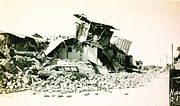1935 Quetta earthquake
British India (now Pakistan) | |
| Max. intensity | MMI X (Extreme)[1] |
|---|---|
| Casualties | 30,000–60,000[2] |
An earthquake occurred on 31 May 1935 between 2:30 am and 3:40 am at Quetta,

Aftermath
Casualties
Most of the reported casualties occurred in the city of Quetta. Initial

Infrastructure was severely damaged. The railway area was destroyed and all the houses were razed to the ground with the exception of the Government House that stood in ruins. A quarter of the Cantonment area was destroyed, with military equipment and the Royal Air Force garrison suffering serious damage. It was reported that only 6 out of the 27 machines worked after the initial seismic activity.[5] A Regimental Journal for the 1st Battalion of the Queen's Royal Regiment based in Quetta issued in November 1935 stated,
It is not possible to describe the state of the city when the battalion first saw it. It was razed to the ground. Corpses were lying everywhere in the hot sun and every available vehicle in Quetta was being used for the transportation of injured … Companies were given areas in which to clear the dead and injured. Battalion Headquarters were established at the Residency. Hardly had we commenced our work than we were called upon to supply a party of fifty men, which were later increased to a hundred, to dig graves in the cemetery.[5]
Rescue efforts
Tremendous losses were incurred on the city in the days following the event, with many people buried beneath the debris still alive. British Army regiments were among those assisting in rescue efforts,
The weather did not help, and the scorching summer heat made matters worse. Bodies of European and
While the soldiers excavated through the debris for a sign of life, the Government sent the Quetta administration instructions to build a tent city to house the homeless survivors and to provide shelter for their rescuers.[citation needed] A fresh supply of medicated pads was brought for the soldiers to wear over their mouths while they dug for bodies in fears of a spread of disease from the dead bodies buried underneath.[5]
|
Significance
The
Notable survivors
Indian space scientist and educationist Yash Pal, then eight-years-old, was trapped under the building remains, together with his siblings, and was rescued.[8]
See also
- List of earthquakes in 1935
- List of earthquakes in India
- List of earthquakes in Pakistan
- List of earthquakes in South Asia
References
- ^ doi:10.7289/V5TD9V7K. Retrieved 22 March 2024.
- ^ ISBN 978-3-540-93818-7.
- ^ a b c d e f "The great Quetta tragedy". Pakistan: Dawn. 25 October 2005.
- ^ Pararas-Carayannis, G. "The Earthquake of May 30, 1935, in Quetta, Balochistan". Disaster Pages. Retrieved 2 May 2013.
- ^ a b c d e f g "1st Queen's at Quetta – The Earthquake". Queens Royal Surreys. Archived from the original on 24 July 2008. Retrieved 5 June 2008.
- ^ "Lungley on www.essex-family-history.co.uk". Archived from the original on 17 July 2019. Retrieved 26 January 2010.
- ^ "No. 34221". The London Gazette. 19 November 1935. p. 7317.
- ^ JAYAN, T. V. (2 August 2017). "For the love of science". Frontline.
Further reading
- Government of India Staff. The Quetta Earthquake 1935. Pagoda Tree Press. ISBN 978-1-904289-34-0.
- Haines, Daniel (May 2019). "Historical Case Study: India 1935: Earthquake" (PDF). Shelter Projects 2017–2018. Global Shelter Cluster. Retrieved 8 January 2020.
External links
- 1935 Quette Earthquake – Dawn
- 1st Queen's at Quetta – The Earthquake
- The International Seismological Centre has a bibliography and/or authoritative data for this event.




